Wetland wildlife
There is so much wildlife to enjoy in the wetlands of the Chilterns – ducks dabble on lakes, rivers teem with trout, and frogs frolic among the bankside flowers. Explore our watery places through the seasons to find out where to go for wildlife, what to spot and what’s rare.
There are lots of great wetlands to visit in the Chilterns AONB, such as College Lake nature reserve, Letcombe Valley Nature Reserve, Little Marlow Gravel Pits (also called Spade Oak nature reserve) and Weston Turville Reservoir. Visit our interactive map to discover even more family days out and wildlife adventures across the Chilterns.
Our rivers and wetlands are very special, playing a huge role in the wider landscape and our own lives. Visit our nature and wildlife section to find out why these things are important in the Chilterns and what we are doing to look after them.
Watching wetland wildlife through the seasons
Read our season-by-season guide to the Chilterns wetland wildlife.

SPRING
As spring arrives, migratory birds that have spent the winter in our wetland habitats take to the wing and leave, replaced by summer migrants. We may say goodbye to many ducks, geese and wading birds, but welcome hobbies, swallows, sand martins and warblers. Birdsong fills the skies in the early mornings as mists rise from still waters. One of the most distinctive sounds of spring is that of the cuckoo, a migrant all the way from Africa. Reptiles and amphibians can be spotted basking in the sun as they come out of hibernation, and ponds fill up with bubbling frogspawn. Flowers burst into life and catkins dangle from willow trees.
What to look out for in Spring
Brown trout (Salmo trutta)
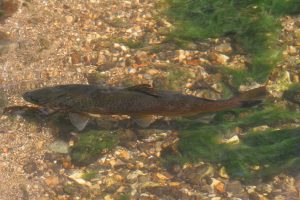 The brown trout is a medium-sized fish that lives in fast-flowing and gravelly rivers and streams; it is particularly fond of the Chilterns’ special chalk streams. It is golden-brown in colour, with a cream belly, dark tail fin and reddish spots down its flanks. It feeds on insects, larvae and small fish. Spring is breeding time and some trout migrate miles to get to their spawning grounds. The females lay their eggs in gravel shallows and the males fertilise them externally.
The brown trout is a medium-sized fish that lives in fast-flowing and gravelly rivers and streams; it is particularly fond of the Chilterns’ special chalk streams. It is golden-brown in colour, with a cream belly, dark tail fin and reddish spots down its flanks. It feeds on insects, larvae and small fish. Spring is breeding time and some trout migrate miles to get to their spawning grounds. The females lay their eggs in gravel shallows and the males fertilise them externally.
Common frog (Rana temporaria)
As the weather warms, amphibians come out of hibernation to breed. Common frogs regularly visit gardens and are probably our most familiar amphibian. They can vary enormously in colour from red-brown to greeny-yellow, and their skin is smooth, not ‘warty’ like a common toad’s (Bufo bufo). They hop about (toads walk) and feast on slugs and snails – very handy for gardeners! Look out for large, jelly-like clumps of frogspawn or long strings of toadspawn appearing in ponds and lakes.
Cuckooflower (Cardamine pratensis)
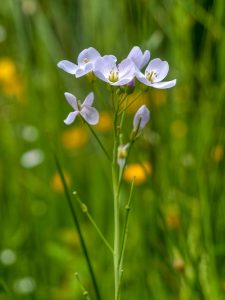 The cuckooflower is a delicate plant with pale pink or lilac flowers that are easily spotted in springtime. Also known as lady’s-smock, it is a perennial of damp places like wet meadows, ditches, pond margins and riverbanks, as well as roadside verges. Its flowers sit atop slender, upright stems and bloom from April – just when the first cuckoos arrive. A sure sign of spring!
The cuckooflower is a delicate plant with pale pink or lilac flowers that are easily spotted in springtime. Also known as lady’s-smock, it is a perennial of damp places like wet meadows, ditches, pond margins and riverbanks, as well as roadside verges. Its flowers sit atop slender, upright stems and bloom from April – just when the first cuckoos arrive. A sure sign of spring!
Water vole (Arvicola amphibius)
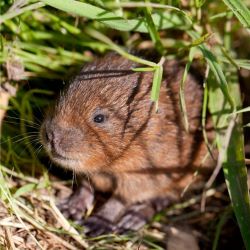 Spring is a great time of year to spot the fluffy, brown water vole in its riverine habitat as bankside vegetation will still be low. This is when they establish their territories and feast on the new growth around them. Look out for the signs that they are around: little piles of poo in ‘latrines’; stems of grasses chomped at a 45-degree angle; and a distinctive ‘plop’ as they dive into the water. If you spot one, take in their furry tails and blunt noses – most unlike brown rats (Rattus norvegicus), which they often get mistaken for. Although they can have four litters of pups a year, they are one of our most threatened mammals, predated upon by the introduced American mink (Neovison vison) and vulnerable to habitat loss.
Spring is a great time of year to spot the fluffy, brown water vole in its riverine habitat as bankside vegetation will still be low. This is when they establish their territories and feast on the new growth around them. Look out for the signs that they are around: little piles of poo in ‘latrines’; stems of grasses chomped at a 45-degree angle; and a distinctive ‘plop’ as they dive into the water. If you spot one, take in their furry tails and blunt noses – most unlike brown rats (Rattus norvegicus), which they often get mistaken for. Although they can have four litters of pups a year, they are one of our most threatened mammals, predated upon by the introduced American mink (Neovison vison) and vulnerable to habitat loss.

SUMMER
Our wetlands are full of life during the summer months, assaulting the senses with colour, smell and sound. Bright orchids bloom along banksides, meadows are a riot of colour and trees are in full leaf. Reeds wave in the wind, with birdsong floating up from among them. Wide skies over deep lakes may be filled with a cacophony of shrieking terns, noisily defending territories, while the gentler buzz and hum of insects is the steady soundtrack of the season. Listen out for crickets and grasshoppers, bees and flies as you watch pretty butterflies dance around daisies, and dragonflies skim the water’s surface.
Photo: banded damoiselle: Nick Fewings
What to look for in Summer
Common tern (Sterna hirundo)
The common tern is the most likely species of tern to be found inland on flooded gravel pits, lakes and reservoirs. They can be spotted hovering above the water before diving in for fish; but you might hear the shrieks of their noisy colonies first! Common terns are very similar in appearance to Arctic terns (Sterna paradisaea), but have whiter bellies, shorter tails and longer, orangey-red bills with a characteristic black tip. Both are silvery-grey above, with black caps and red legs. Common terns nest on the gravelly shores of waterbodies and will attack any intruder to their territory.
Daubenton’s bat (Myotis daubentonii)
Daubenton’s bats are a medium-sized bat, around 5 cm long, with a wingspan up to 27 cm. Specialists of wetland areas, on summer evenings, they emerge from their roosts in tree holes and tunnels to feed on caddisflies, mayflies and other insects. These fast fliers hunt using echolocation (the bouncing echoes of their own calls give them information about their surroundings), skimming the water’s surface and scooping up insects with their claws. During the summer, females form maternity colonies to have their pups. They hibernate underground over winter.
Emperor dragonfly (Anax imperator)

Photo: emperor dragonfly, Heather Wilde
Dragonflies and damselflies happily flit about our wetlands in the summer months. There are lots of different species to look for, but the emperor dragonfly is certainly one of the most impressive. With a length of nearly 8 cm, it is a very large dragonfly. Male emperors are blue with a green thorax and black stripe down the body, whereas females are greener in colour. From June to August, emperor dragonflies can be seen around ponds, lakes, canals and ditches, chasing their insect prey.
Yellow flag-iris (Iris pseudacorus)
 A common plant of wetlands, particularly stream and pond margins, fens and wet woodlands, the yellow flag-iris is easily identifiable when in flower because of its large, drooping, bright yellow petals.
A common plant of wetlands, particularly stream and pond margins, fens and wet woodlands, the yellow flag-iris is easily identifiable when in flower because of its large, drooping, bright yellow petals.
Its tall stems (up to 1.5 m) and sword-like leaves rise above other marginal plants or mingle with the reeds in our fens. It is thought that the flower inspired the ‘fleur-de-lis’ heraldic symbol.

AUTUMN
Our wetland habitats change from the bright greens and blues of summer, to the gilded hues of orange, brown and gold in autumn. Trees display autumnal colours, vegetation dies back, and floodplains and lakes fill up as the rain falls. Summer migrant birds leave for more exotic shores, but are replaced with our winter migrants, looking for a clement place to spend the colder months. Look out for flocks of pink footed geese and brent geese, waders like lapwings and dunlins, and fieldfares and redwings. This is also the time when many trees and shrubs produce their fruits – adding more colour to the season and a tasty feast for birds, animals and humans alike.
Photo: Duncan Brown
What to look for in Autumn
Kingfisher (Alcedo atthis)
 Perhaps one of our most easily recognisable and iconic wetland birds, the kingfisher is loved for its bright, metallic blue and copper feathers. Common around rivers, streams, canals and lakes, look out for a bright flash of colour as it darts along the bank. You might spot one perched on a branch above the water, patiently waiting for a fish to swim underneath. Watch it dive with absolute precision into the water to catch it! Kingfishers live in burrowlike nests along the banks of waterways and lakes.
Perhaps one of our most easily recognisable and iconic wetland birds, the kingfisher is loved for its bright, metallic blue and copper feathers. Common around rivers, streams, canals and lakes, look out for a bright flash of colour as it darts along the bank. You might spot one perched on a branch above the water, patiently waiting for a fish to swim underneath. Watch it dive with absolute precision into the water to catch it! Kingfishers live in burrowlike nests along the banks of waterways and lakes.
Little egret (Egretta garzetta)
 The little egret is a small white heron, with black legs, yellow feet and a long, black bill. During the breeding season, it grows a long, white plume from its crown and longer feathers on its breast. It can be seen all year-round in the UK, but numbers swell in autumn with the arrival of migrants from Europe. Look out for it stalking shallow waters for amphibians, fish, reptiles, birds and crustaceans to feed on.
The little egret is a small white heron, with black legs, yellow feet and a long, black bill. During the breeding season, it grows a long, white plume from its crown and longer feathers on its breast. It can be seen all year-round in the UK, but numbers swell in autumn with the arrival of migrants from Europe. Look out for it stalking shallow waters for amphibians, fish, reptiles, birds and crustaceans to feed on.
Otter (Lutra lutra)
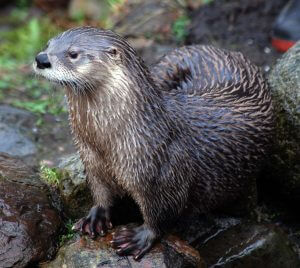 The secretive otter is a very recognisable mammal of our waterways when actually spotted! But you are more likely to see the signs that one has been around: spraints (poo) left in prominent places near the water; five-toed footprints along muddy banks; and their bankside burrows, known as ‘holts’, where they have their cubs. Otters have brown fur, a rounded snout, a pale throat and chest, and webbed feet. They are large and powerful swimmers, expertly hunting fish, waterbirds, amphibians and crustaceans.
The secretive otter is a very recognisable mammal of our waterways when actually spotted! But you are more likely to see the signs that one has been around: spraints (poo) left in prominent places near the water; five-toed footprints along muddy banks; and their bankside burrows, known as ‘holts’, where they have their cubs. Otters have brown fur, a rounded snout, a pale throat and chest, and webbed feet. They are large and powerful swimmers, expertly hunting fish, waterbirds, amphibians and crustaceans.
Spindle (Euonymus europaeus)
Spindle is a relatively ordinary-looking, small, deciduous tree, with shiny green leaves and small cream flowers during spring and summer. But in autumn it really comes into its own: its leaves turn russet red and bright pink-and-orange berries adorn its stems. Birds, mice and even foxes like to eat these popcorn-like berries, but they are poisonous to humans. Spindle can be found in many habitats from garden to grasslands, wet woods to riverside hedges. Its wood was used to make spindles for holding wool – hence the name.

WINTER
As our wetlands fill with rainwater, numbers of wading birds and wildfowl increase – many migrants still arriving from colder climes. Wigeon, teal, pochard, goldeneye and pintail are just some of the ducks visible on the waterbodies of the Chilterns, regaling us with their beautiful breeding plumage at this time of year. Deciduous trees like willow and alder lose their leaves for the winter, making this a good time of year to see their shapes and forms. Even without leaves, it’s possible to identify trees just from their bark, twigs, buds and general shape. Wetland animals have different ways of coping through the winter months: some, such as bats, reptiles and amphibians, go into hibernation; while others use food stores they’ve collected through the autumn.
Photo: wigeon, Belinda Fewings (Unsplash)
Alder (Alnus glutinosa)
This water-loving tree is found in damp places, such as wet woodlands, along riverbanks and at the edges of ponds. Its bark is dark and fissured and its leaves are rounded. In winter, it can be identified by its catkins: the male flowers are long, yellow-brown catkins that appear in February; the female flowers are small, green ‘cones’ that turn red and hard when pollinated and stay on the tree all year-round. Alder wood does not rot under water, so was traditionally used for shoring-up the banks of waterways.
Pintail (Anas acuta)

Photo: Matthew Schwartz
In winter, the wetlands of the Chilterns play host to a huge variety of ducks, many flying in from colder climes, bolstering our resident populations. Ducks are generally split into two kinds: dabbling ducks feed at the surface, dipping their bills or heads in the water; while diving ducks dive under the surface and swim for their food. One of our winter regulars – the pintail – is a dabbling duck that eats plants and insects. The males are distinctive in their breeding plumage at this time of year, with chestnut heads, white necks, grey bodies and characteristically long, pointed tail feathers.
Pochard (Aythya ferina)
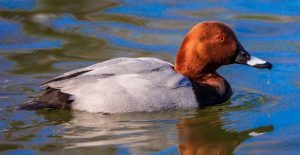
Photo: David Waite (unsplash)
In winter, the wetlands of the Chilterns play host to a huge variety of ducks, many flying in from colder climes, bolstering our resident populations. Ducks are generally split into two kinds: dabbling ducks feed at the surface, dipping their bills or heads in the water; while diving ducks dive under the surface and swim for their food. One of our winter regulars – the pochard – is a diving duck, eating plants, insects and small fish. The males are distinctive in their breeding plumage at this time of year, with rusty-red heads, grey bodies and black chests. Pochard are quite similar in appearance to two dabbling ducks: wigeon (Anas penelope) and teal (Anas crecca). However, wigeon have pink breasts, white wing patches and yellow foreheads, and teal have bright green eye-stripes and wing patches.
White willow (Salix alba)
The name ‘willow’ covers a variety of species of willow tree. In the Chilterns, look out for white willow, with silvery-white leaves; goat or ‘pussy’ willow (Salix caprea), with its distinctive silvery, fluffy catkins; and crack willow (Salix fragilis), which has gnarled trunks that can split and branches that break easily with a loud, cracking noise. All these willows can be found along riverbanks and ditches, in wet woodlands and reedbeds, and around waterbodies. Goat willow is a small, scrub-forming tree, whereas white and crack willows are large, fast-growing trees. Willows are often pollarded – pruned to remove the upper branches and allow light through to the water below.

Wetland wildlife under threat
Wetlands are naturally evolving features of the landscape, but their important habitats and characteristics are being lost at an alarming rate due to climate change. There are many other threats to the survival of our wetland heritage, too, including pollution, habitat loss and invasive species. Find out how we are tackling these threats and how you can help.
Photo, dunlin, Bob Brewer

Managing the Chilterns’ special habitats
Wetlands and other habitats in the Chilterns need protection, management and restoration, so that the wildlife living there can thrive and for our own well-being, too. The Chilterns Conservation Board (CCB) looks after the Chilterns AONB, working with partners and stakeholders to ensure its future. Find out what we do and how we protect, enhance and restore our wonderful landscape.
Photo: College Lake, by Anne Rixon

Bookable experiences
Featured walks

Upcoming events
Plan your trip to the Chilterns!




